Tim Gentles – 7 January, 2013
The addition of new works, all anonymous and relatively collective in execution, throughout the duration of the show threatens the stature of both the curator and the individual artist….and yet there is no denying the career-building potential of such a show. While these young artists work to shape the gallery to their liking, they must ultimately cede sovereignty not just to the physical limits of the space, but to the idea of the Artspace New Artists Show, in which their role is perhaps already prescribed as 'youthful vitality.'
Auckland
New Artists Show Part 2
Drinking from the Fire Hose
6 December - 20 December 2012
This year Artspace made the decision to break up their annual New Artists Show into two parts, and where the first part followed the somewhat conventional model of exhibiting a diligently curated handful of up-and-coming recent graduates, for the second part of the show curator Catarina Riva has adopted for a more anarchic approach. Essentially giving the gallery space over to 21 AUT Fine Arts students to do with it what they will, Drinking from the Fire Hose is an interesting exercise in institutional upheaval.
While it’s certainly possible to object to the showcase-like, capital-driven obsession with newness of calendar fixtures such as the New Artists Show - as Mark Harvey did in his review of the first part of the exhibition - breaking the show up into two parts has if anything highlighted the diversity of what the new can mean. Far from placing Artspace in the position of an art world gatekeeper, this second iteration of the New Artists Show doesn’t name its artists, marking them instead with an anonymous, slightly feral, youthful creative energy, and allowing them free reign to overturn an institution in which as yet they have no place.
The expectation around the show was that significant architectural alterations had been made to the interior, and upon arriving on opening night and having to walk through a makeshift plywood tunnel, this was thoroughly confirmed. The effect on the space was immediately apparent, and coupled with part of the wall between Artspace’s main and smaller rooms being removed, the changes reconfigured the dynamic between openness and claustrophobia in different parts of the gallery. These ‘spatial interventions’ only became more important as the show went on, where works were continuously added to the gallery, which began to seem more like an obstacle course, upsetting the viewer’s ability to competently navigate the gallery space.
Such spatial intervention may also serve as an analogy for the relationship between the young exhibiting artists and Artspace as an institution, if not the institution of the art world as a whole. The addition of new works, all anonymous and relatively collective in execution, throughout the duration of the show threatens the stature of both the curator and the individual artist, and instead the show seems to take on a life of its own, growing organically and overrunning the gallery. There seems to be a concerted desire on the artists’ part to make their mark on the gallery in quite a literal, i.e. physical, way. And yet there is no denying the career-building potential of such a show, while these young artists work to shape the gallery to their liking, they must ultimately cede sovereignty not just to the physical limits of the space, but to the idea of the Artspace New Artists Show, in which their role is perhaps already prescribed as ‘youthful vitality.’
If the open-ended and constantly evolving form of the exhibition is as important as the specific content of the works exhibited, this content nevertheless deserves some attention here. Namely, given the scope of the exhibition as a (perhaps) representative sample of the best that AUT Fine Arts students have to offer, there are a number of currents which might be taken, in turn, as representative of emerging trends in contemporary art, and which indeed contain certain resonances with some of the work exhibited as part of this year’s recent Elam Graduate Show.
In many respects the works are presented in the same anarchic mode as the exhibition format suggests, with a work demonstrating a keen archival impulse (in which a cabinet displays the contents of a “timeless capsule” purportedly created by Dane Mitchell in 1997), buttressed against other works of a decidedly more contemporary grain (images of manicured nails and the sculptural use of potted palm trees will be familiar to anyone with a vague awareness of tumblr art/contemporary art daily). There is a randomness here that seems to deliberately elude containment, and is suggestive of a collaborative approach that encourages viewing the show as a series of ‘continuities’ rather than discrete works. Themes and similarities fade in and out of view, and in the fluid, cluttered confines of the exhibition space some works jar with others, but there is a continuity between many of these works that extends beyond their shared proximity and anonymity. This continuity is presented in the form of a collaborative organicism, a reading which the buzzing, studio-like atmosphere of the exhibition (at least when I visited, for the second time, a few days before closing) certainly encourages.
Rootless but referential, Drinking from the Fire Hose has something like the texture of net culture, being both wildly impulsive and heterogeneous, and yet the works can be grouped together according to certain themes or threads, like the prevalence of a certain shade of pink that comes up in work after work and which played a key role in the opening night performance. This dynamic speaks to some of the emerging antagonisms of contemporary art, between the art institution and without, between the different spaces that art can inhabit, between fine art and other visual discourses, such as interior design and net culture, and the sticky notion of authorship.
Tim Gentles
Recent Comments
Roger Boyce
Hey now. Back from grid-free Farewell Spit where I didn't ... although a familiarly long-playing thanatopic spell was reciting itself ...
Ralph Paine
OK, for me the problematic is always neutral yet immanent. In other words, the problematic - in this case, the ...
John Hurrell
Ralph, I wonder if I am misrepresenting Kester? On the one hand he writes "This ambivalence, the semantic slippage between ...
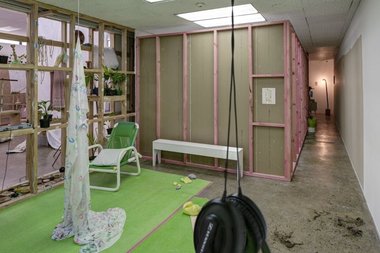
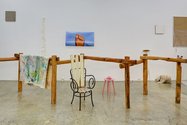
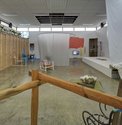

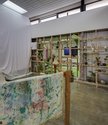
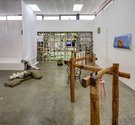
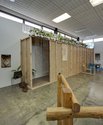
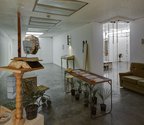
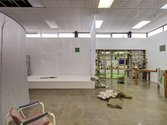
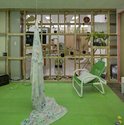
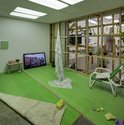


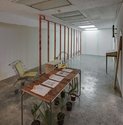
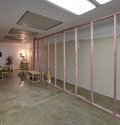

 Two Rooms presents a program of residencies and projects
Two Rooms presents a program of residencies and projects Advertising in this column
Advertising in this column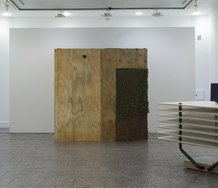
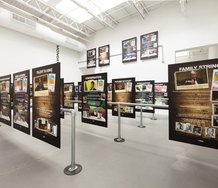

This Discussion has 14 comments.
Comment
John Hurrell, 9:16 a.m. 7 January, 2013 #
I wonder if this show is a metaphor for the much wider, online global social space, esp. the use of 'de-branding' art practices often discussed by artist/writers like Brad Troemel
http://bradtroemel.com/index.php/project/speaking-in-public/
Tim Gentles, 8:12 p.m. 12 January, 2013 #
Metaphor may be a tad too strong, but yes I think so. Perhaps it is more that the show inevitably mimics the language and logic of such a online social space, in which the autonomy of the individual collapses into various forms of collaboration. The individual artist, then, is subsumed into the networks and relations within which they are nodes (perhaps, this is why artists are supposedly more like curators than ever before, with their work increasingly falling under the domain of re-purposing, referencing, etc).
So while I don't think this show was necessarily 'about' the internet, it maybe just reflects the interconnectivity of online media, which at this point is fairly inescapable.
Roger Boyce, 9:21 p.m. 9 January, 2013 #
Part 1
Dana Schutz once entitled an exhibition Self Eaters and the People Who love Them… which, in the remembering, cues me to ponder a conversation I recently had; with my neighbor’s sister’s friend’s husband’s disabled lover … about Tim Gentles’ piece interpreting (yes, interpreting) Part 2 of Artspace’s New Artists Show. And why it doesn’t really matter that the concertina-wire ring-fence ‘cerebration’ in Gentles’ surround-them-and-they’ll-come-out-with-their-hands-up-when-they-run-out-of-food-water-air-and-adjectives-style essay went pretty far out of its way to remind me of why I can barely get up for, or, for that matter, ‘get it up’, to write art-criticism. And what – by negative example - makes art writing and visual art an attractive proposition…or not.
I have to come clean and admit here that I don’t get out much anymore. Which gets me to thinking about a famously ubiquitous fellow in NYC who was once actually famous (or was it infamous) for getting out and going to just about every danged visual art-world thing there was. This was, in fact, a coincidental point in time when I wasn’t going to much of anything in NYC…but if, on the off chance, I was obligated to go to something … there that blamed fellow would be. Which is kind of like the bare 4x2 ‘walls’, dead & dying pot plants, bits of op-shop furniture and hanging, slightly soiled, sheets that feature in any number of Aotearoan shows I’ve walked into over the past seven years. Although, as I’ve said already, I don’t get out much at all.
It must take some doing to work up a written piece, to pump it up - as musicians would have it - about this sort of eternally returning (apologies to Nietzsche) scatter of unprepossessing things. A scatter of unprepossessing things that gets cyclically re-branded, and rebranded, AND rebranded as a “youthful creative” exercise. To work up the gumption to describe its predictable squalor (squalor is even too live a term) as anarchic and feral. To fire up florid images of institutions in upheaval (upheaval, by Odin!) overturned by (of all things) spatial intervention. Spatial intervention. Foreboding French horns about here.
It used to be that the artworld and art writers were enamored of faux-militaristic tropes such as ‘to-appropriate’ as in to provisionally take… now they seem to have turned their affections to the popular language of (big R) recovery. Let me now use it here in this sentence and see how it feels…..i-n-t-e-r-v-e-n-t-i-o-n. Mmmmmmmm.
Intellectual Intermission:
That felt good, now didn’t it? It doesn’t really matter where that good feeling resides, or where it might flow to next, or where it needs to flow to (now) to feel the very best it can feel? The only thing that really matters now is the feeling we get when we really feel it moving to that perfect spot?
Roger Boyce, 9:22 p.m. 9 January, 2013 #
Part 2
Intervention being a 12-step method wherein extended family saves extended family from self-destructive personal habits. Spatial intervention would be, I’d guess, saving a prototypically clean well-lighted space from itself and its purpose-designed spatial tendencies? Redemption of habit-driven institution … addicted to doing the same thing over and over (with its clean well lit space) while expecting different results? Someone needs step-In, to intervene. That much is clear. Am I being ironic here?
I’m tired of writing this. Weary of writing anything at all. And don’t you know how tired you are of reading it? By the end of this text I’ve pert-near forgotten what the show even looked like (or if it was about looking or thinking about looking?). And, as we’ve been told, the artists (like 12 step talk-circle participants) are/were anonymous. But – sticking with the ‘recovery’ model we do know, and remember the group ‘facilitators’ -Catarina Riva and Alex Davidson – names who “- cede sovereignty –''. You see, they aren’t IN recovery – the institution IS, with the help of an anonymous support group. A group who anarchically share out the sovereignty they have been, so magnanimously, given by the exhibition’s institutional and curatorial ‘facilitators’. In the 60’s such a strategy would have been referred to as cooption.
How this show “- threatens the stature of both the curator and the individual artist “ or how reportedly “- there is no denying the career-building potential of such a show, -'' escapes me completely.
So tomorrow morning, before going off the grid, for a 10 day Farewell Spit I’ll run the previous paragraph past my neighbor’s sister’s friend’s husband’s disabled lover …and see what he thinks.
Luke Munn, 11:09 p.m. 9 January, 2013 #
"like the prevalence of a certain shade of pink that comes up in work after work and which played a key role in the opening night performance"
This connection to net art reminded me of an interview with a veteran web designer, talking about the relatively recent shift to 'responsive design', in which the site must adapt to the various screen resolutions, ratios and technical constraints of a range of a hardware and software (iPhone, Android, PC, etc). He commented how the idea of a fixed layout or look is now irrelevant, how instead brands should seek to establish a set of fluid elements, a kind of lightweight visual lexicon which can provide continuity when moving across devices and spaces.
So who makes this work and how does 'career building' function in this kind of exhibition, where individual pieces disintegrate into an extreme form of pervasive 'ambient' installation? Do the artists give up their own projects in favour of a cohesive aesthetic or approach? In this model, the physical exhibition seems closer to a shared digital platform.
It recalls something like Nasty Nets, founded in 2006 when Facebook was still relatively unestablished, allowing a range of net or new-media artists to collaboratively blog. In this model too, a relatively stable group aesthetic evolved, eschewing much of the individuality of the contributors. Perhaps due to the sharing mechanisms prevalent here, personal authorship is easily given up, replaced instead by the 'reblog' - the potted palm trees and shade of pink that is distributed throughout the space.
Roger Boyce, 8:46 a.m. 10 January, 2013 #
Tragedy of the Commons:
Who gets paid and who gets laid is the age old question that defines lines of power in any given social construct.
Disregarding the dubious benefits of an 'anonymized' creative sector, I, at least, am moved to ask -in this situation -as in every...who's getting laid and who's getting paid here?
If creatives are not manning the kettle drum on the deck of the galley (setting the beat, so to speak) but are instead working unseen, as a team, below decks (on the oars) then who's on the drum and who's on the tiller? And where might they be taking this thing ... on whatever private and public funds are paying the salaried portion of the crew? Who's getting laid and who's getting paid here?
Were the anonymous collective of artists in the show paid a collective or individual fee. Were they afforded a materials and production budget (if not then perhaps there lies the answer to why so many shows of "youthful creative" types are furnished with off-cuts, op-shop finds and on-sale pot plants?
Were the curators of the exhibition, the director and other administrative staff of the space drawing a salary (salaries that pay for rent, utilities, victuals, etc.) to man the tiller and kettle drum during the course of the exhibition. That, by the way, is called a rhetorical question.
The web, the internet's (if that model is what's being adopted in this exhibition - as opined by the reviewer and Mr. Munn) large unanswered question (in a late capitalist society) unsolved problem is how to monetize production, content, whatever.
The old artworld model of hyper-stylistic-individuation with its recognizable practitioner-specific content sets up a monetary ecosystem that allows for its more robust and vigorous participants to get paid and laid.
If the new model is one of anonymized practitioners and heterogenously organized content requiring translation by temple priests (i.e. critics/reviewers) then it stands to reason that directors, curators and arts administrators will be the only artworld denizens being paid and critics will write in the (futile) hope of getting (access and) laid.
Fat chance.
I really am off to Farewell Spit now....as my 7 year old is nagging beyond resistence.
Ralph Paine, 6:09 p.m. 12 January, 2013 #
To include more causes here than money and sex would be advantageous re any Nietzschean-inspired move beyond resentiment: e.g. happiness through sociability and recognition, the pleasure of company in apprenticeship, the pleasure of time out, the sharing of fantasy and affect, the joy of cooperation, the aim of having no aim but the gentle collapse of a few years spent living and learning together... Which - given the possible ebbs and flows and redistributions of wealth, Eros, and power (the possible reconfigurations of culture) - would in no way imply being anti-money or anti-sex.
John Hurrell, 6:56 p.m. 12 January, 2013 #
'The pleasure of company in apprenticeship... the joy of cooperation'. Is the art of nameless individuals in a group as collaborative as Ralph suggests? Maybe that is not desirable? Grant Kester in the introduction to his 'The One and The Many: Contemporary Collaborative Art in a Global Context' reminds us that the primary meaning of 'collaboration' is 'to work together', but that its secondary connotation is 'to cooperate treasonably, as with an enemy occupation force.' Perhaps as Kester says, this is a 'semantic slippage' involving 'a counter-meaning: a warning of...its ethical undecidability.'(p.2)
Ralph Paine, 11:52 a.m. 13 January, 2013 #
Yet more cynical reasoning John? No doubt a requirement when trying to think in the "global context". That is to say, with Capital fixing the agenda.
There seems to me something akin to an art of living (& learning) displayed here in the exhibition. What brings all this together? What causes it? What fascinates and attracts? Certainly there is a suspension of certain kinds of naming, certain kinds of language, and thus an evaluation of certain forms of power and obligation is being practised.
But rather than works by a group of nameless individuals, what we have is a work assembled using the beautiful proper name 'Drinking from the Fire Hose'. In other words, subject/object distinctions seem suspended here, as do the oppositions between studio and gallery, classroom and living quarter, & so on. Hence the installation is not simply the record or trace of a year at art school, but the wonderful year itself.... Suspended, floating, out of joint, untimely even: Yes, this!
Likewise, in order to experience such an approach, the friend/enemy distinction, the war analogies, the problems of leadership in group formations, conflict and disagreement, etc., have all been substituted by different concerns, different and way more chilled-out aporias.
Pure fancy? Of course, but doesn't art travel under the guiding star of The Fanciful?
John Hurrell, 12:32 p.m. 13 January, 2013 #
I was surprised to hear it from Kester, a very vocal champion of collaborative art. I admire his candour.
The title is - as you say - beautiful and fanciful. And like Kester, candid. Young artists (though unnamed) drinking from the institution's teat. With a long reach, high pressure and flexible.
Ralph Paine, 1:23 p.m. 14 January, 2013 #
I've just now had a read on Amazon Books of the 'Introduction' in Grant Kester’s “The One and the Many: Contemporary Collaborative Art in a Global Context”, and it seems evident that with your earlier quote and warning you misrepresented his thinking. In the passage you quote from he is dealing with names, and yes, he considers the two meanings of the name ‘collaboration’. But he immediately qualifies things by stating that ‘[t]here are of course, no unequivocal signifiers’, and that nothing can be sorted out ‘at the level of terminology’: hence the rest of the long academic ramble through the global context.
In any case, this looks like the kind of book that would cause our friend Mr Boyce to get all Biblical in tone and start ranting about there being nothing new under the sun. And he might have a point. For others, I'm sure it would be a fascinating luxury.
As for the name “Drinking from the Fire Hose”, rather than any sucking at the teat of the institution, for me it conjures up images like those of hot summer streets in NYC where the kids have turned on the fire hydrants and are playing in the gushing cool water.....
Free water!
John Hurrell, 9:34 p.m. 14 January, 2013 #
Ralph, I wonder if I am misrepresenting Kester?
On the one hand he writes "This ambivalence, the semantic slippage between positive and negative connotations, is, I think fitting," and then later as you correctly point out, he says "There are of course, no unequivocal signifiers, just as there is no art practice that avoids all forms of co-option, compromise or complicity."
That he then states "It seems wiser to openly acknowledge this impurity than to assume that it can somehow be defeated at the level of terminology" is perhaps a subtle way of attempting to 'sort (it) out', albeit only by articulating the problem. He is after all examining the situation.
I like your description of Roger being 'Biblical in tone'. Hopefully when he gets back 'on the grid' he'll respond. Out of perversity he might even agree.
As for the 'Fire Hose' title, I think it refers to the venue in K'Rd specifically - rather than Harlem and some sort of Magnum fantasy - connecting well with Tim's perceptive comments on the institution and its relationship with the nameless but 'new' artists.
Roger Boyce, 5:02 p.m. 19 January, 2013 #
Hey now. Back from grid-free Farewell Spit where I didn't ... although a familiarly long-playing thanatopic spell was reciting itself stronger than ever, and its incantations only further strengthened by this thread's dreary text-bound badminton. I have a stiff neck already from watching the little shuttle-cocks waft over the gossamer threaded inter-net. Or should I say funnel-spider's web.
Now y'all (ad hominem warning) let me get all "biblical" on your ass. As in Paine in the.....
Paine as per usual wears his Tefillin, or phylacteries, on the left arm as required. But in his two small black leather (leather = hide-bound) boxes aren't passages commanding the chosen to bind the word of God to their corpus, but instead well thumbed (but little understood) scraps of oblique and circuitous Gilles Deleuze and Félix Guattari texts.
One is always art-world-safe holding forth with such texts as only acolytes pretend to their understanding and instead of riskily engaging in fresh-coined intellectual exchange such initiates trade 'unopened' Deleuze & Guattari phylacteries in the same way that baseball card fanatics trade high-value emblems of their no less mundane obsession.
If the artworld had altar-boys then Mr. Paine would hold the station of Server - the boy holding, and hugging to his tiny chest, liturgical books for the celebrant.
If the celebrant role needs be exclusively reserved for, or must be about, Deleuze then one would be wise to heed the lifelong academic Prof. Deleuze's view on academics as a species and academic style discussion.
Deleuze, who was a virtual shut-in knew what he was talking about when he said "Academics' lives are seldom interesting." Having spent only the autumnal years of my life in academia I'd still risk adding that not only are academics lives seldom interesting but so too goes their arguments ... which seem to grow from little more than their own privileged and mostly solipsistic experience of other academic and their seldom interesting texts.
Imagining anyone investing the fugitive moments of an oxidizing-world-on-fire poring over (yea, verily eating) and regurgitating dry-dry pages makes me unhappier than a hound dog who after eating peaches must void (pass) the pits.
Thus, laying this fragrant cable, I'm outta this thread - no matter Mr. Paine (or John's) rejoinder ... if any.
Be well, me hardies.
Ralph Paine, 11:51 a.m. 15 January, 2013 #
OK, for me the problematic is always neutral yet immanent. In other words, the problematic - in this case, the elemental asking of the question "What is collaborating?" - is independent of both the negative and the affirmative. Hence: the problematic is the virtual condition of collaborating, a pure dynamic engendering all actual acts of collaboration as the expressed, answered, or conditioned of itself.
And yet each solution qua solution nevertheless does possess its own power as organising principle, and in this manner each presupposes and in a quasi-reciprocal manner helps produce the neutral - neither active nor passive - problematic to which it adheres. So again, nothing can be sorted out at either the 'level of terminology' or by simply articulating the problematic, but as you imply, only by linking those within actual and very specific situations...
Voilà, the case at hand: Drinking from the Fire Hose; a situation which seems to suspend the negative in favour of the affirmative. Or, does it suspend both the negative and the affirmative in an attempt at attaining the neutral?
Participate
Register to Participate.
Sign in
Sign in to an existing account.